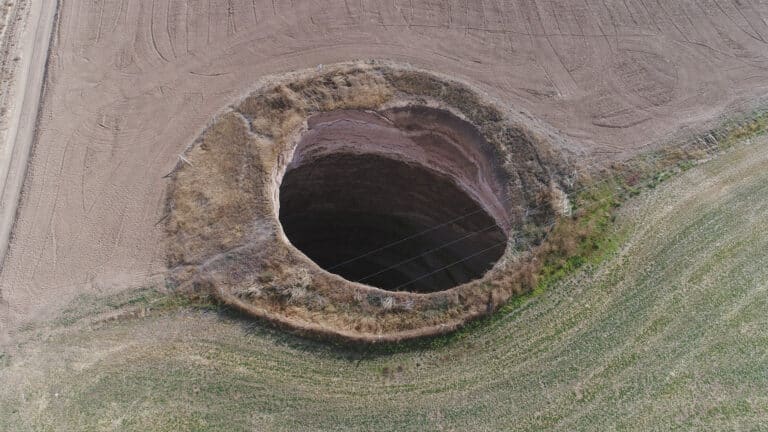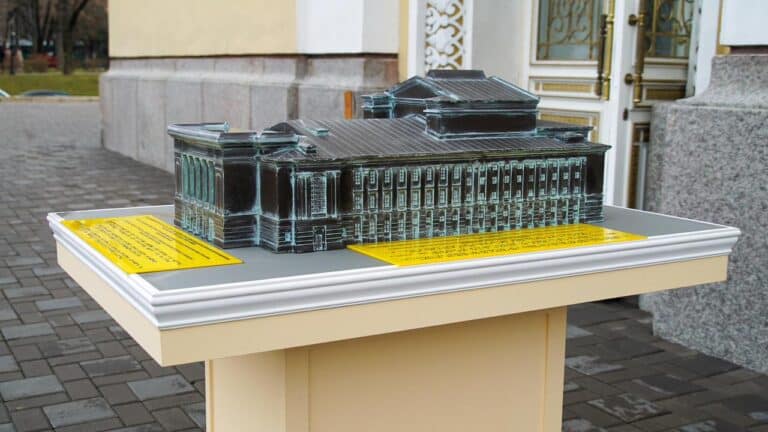
For the seventh month, Freedom Finance Global has been studying consumer confidence, inflation and devaluation expectations of residents of Central Asian countries: Kazakhstan, Uzbekistan, Kyrgyzstan and Tajikistan. The first month of 2024 showed how public sentiment changed after the New Year holidays, which could affect the results as a seasonal factor.
However, January saw an improvement in consumer confidence in three countries, two of which reached new seven-month highs in the Freedom Finance Global survey. In general, the ranking of countries has not changed: Tajikistan still shows the greatest optimism. At the same time, inflation expectations and perceptions in the region fell sharply in January, thereby continuing the trend set in December. Amid these facts, we conclude that price concerns among Central Asians have taken a structural step back giving central banks more room to ease monetary policy.
Let us add that in Kazakhstan and Uzbekistan, analysts collect 3,600 questionnaires per month, in Kyrgyzstan – 1,600 and 1,200 in Tajikistan, commensurate with the size of the population in the countries studied. The research is based on the methodology used to obtain consumer confidence indexes in many countries around the world and adapted to local needs by the United Research Technologies Group research company. Data collection method: telephone survey. The survey questionnaire is localized: the study is conducted in the native language of the respondents.
Kazakhstan
In Kazakhstan, the Consumer Confidence Index (CCI) fell by one and a half points in January, and this was the second decline in a row. The index fell to 103.2 points, which is still 3.4 points higher than the January 2023 result. The annual growth was made possible due to increased optimism regarding the short-term prospects of the Kazakh economy. On the other hand, a monthly decline is observed in all five sub-indexes from which the final result is calculated. The sub-indexes of the prospects and assessments of the personal financial situation of Kazakhstanis fell the most: both by 2 points. Moreover, the sub-index of expectations for the economy in the one-year horizon fell more noticeably than others.
Financial situation slightly worsens
The subindex of actual assessment of changes in personal financial situation over the past 12 months decreased by 2 points. In January, 31.6% of Kazakhstanis believed that their personal financial situation had improved over the year. Compared to the record November, the decrease turned out to be significant, since then there were 37.9% of such people. Nevertheless, the index remains in the positive zone, since 26.5% of respondents gave a negative answer. In terms of age, the previous dynamics continue to persist: the younger the respondent, the more positive the answer. Among young people under 29 years of age, 45% gave a positive answer (48% in December), and among the over-60s, the same figure was only 23%. Regionally, the western regions continue to be leaders. This time, the garland of victory of the Atyrau region was taken over by the Mangystau region, where the share of positive responses reached 32%, and negative only 14%. The second place is occupied by the Kyzylorda region, where this ratio was 30 to 15%. Next on the list are Atyrau and Aktobe regions. The worst indicators were recorded in the Kostanay region: the share of positive responses fell to 22% there.
Similarly, the sub-index of expectations for changes in personal financial situation decreased by 2 points in January. Slightly fewer Kazakhstanis began to believe that their financial situation will improve during the year: 51.6% versus 53% in December. The share of negative responses also increased slightly, from 8 to 9%. Kazakhstani youth show the greatest optimism here too. Two-thirds of respondents under 29 years of age expect an improvement in their personal financial situation. Among the oldest generation, the share of optimists was only 35%. Nevertheless, the largest monthly decline is observed in dynamics among young people: 4% versus 1% among the older generation. Regionally, the absolute leader is the Mangystau region, where 71% of residents expect an improvement in their personal financial situation. It also recorded the largest month-on-month improvement in the positivity rate, which was only 50% in December. Residents of the Kyzylorda and Turkestan regions also showed good optimism. The weakest results are observed in East Kazakhstan region, where only 40% of respondents are optimistic about the future.
Fewer young people are optimistic about economic prospects
The subindex of expected changes in the economic situation in the short term decreased by 1.6 points in January reaching 133.1 points. Despite this, we note that expectations continue to remain at a fairly high level for seven months. The average index reached 113.9 points in the first half of 2023, compared to 131.7 points over the last seven months. This indicates a structural improvement in the economic expectations of Kazakhstanis over a one-year horizon. Interestingly, such dynamics are not observed for other subindexes.
In January, 55.4% of Kazakhstanis gave a positive answer regarding economic prospects for the coming year. We note that this is higher than in December when there were 53%. The decrease in the subindex became possible due to an increase in the share of negative responses from 8% to 13.5%. The age breakdown indicates some reversal of the previous trend. Young people under 29 have lost their leadership and do not expect the economy to improve. The share of positive responses among young people decreased from 64 to 57%, while for other age groups, this figure remained virtually unchanged. As a result, the spread of results by age was reduced significantly. Among the oldest generation, the share of positive answers reaches 53%, while among middle age groups; the result was only 1–2 percentage points lower than among young people.
In regional terms, the leadership continues to be held by the Turkestan region, where 62% of residents are optimistic about economic growth. Slightly less positive is observed in the Kyzylorda region, Astana and Shymkent. Residents of the East Kazakhstan region again responded worst of all, where only 42% gave a positive answer. The next is the West Kazakhstan region, where the share of negative responses over the month has sharply increased from 11 to 22%.
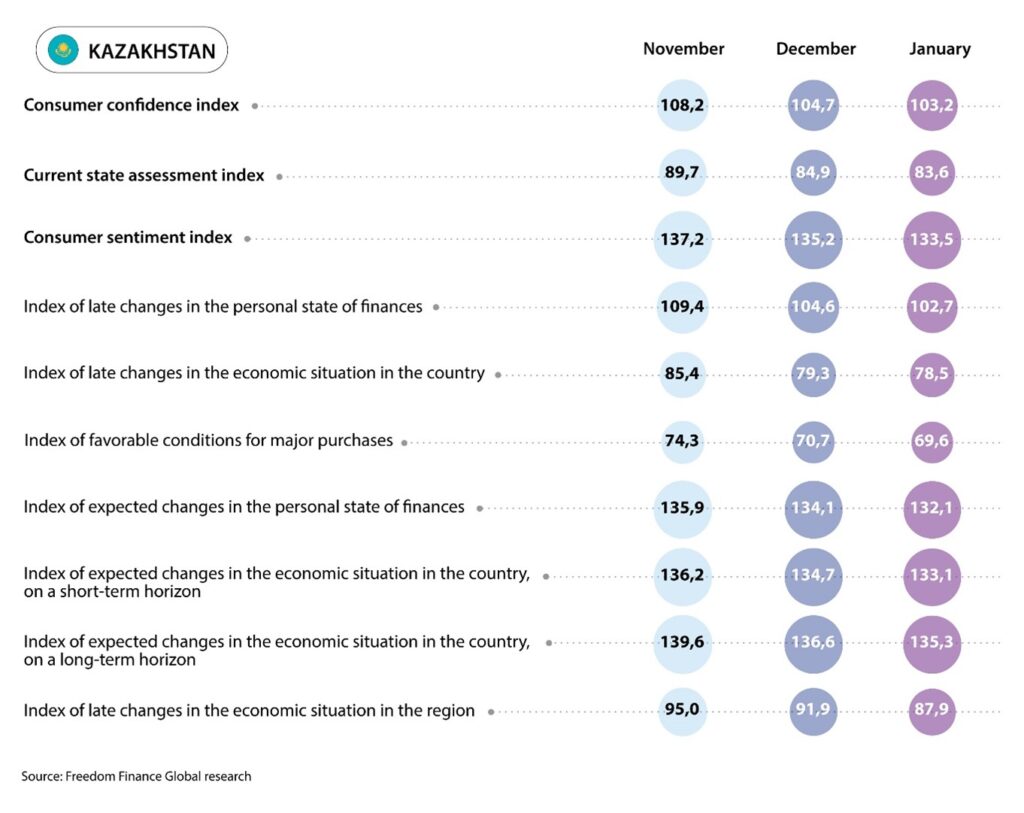
Inflation expectations and perceptions have taken a big step back
Inflation perceptions of Kazakhstanis dropped to record lows for all 13 months of observing this indicator. 45.4% of residents (48% in December) noticed a strong increase in prices during January. At the same time, over the past 12 months, the share of those who noted a significant increase in prices fell for the eighth month in a row and reached a new low: 58.3% versus 58.7% in December. A year ago, almost at the peak of inflation, this share was 73.3%. Let us remind you that annual inflation continued to slow down in January and is 9.5%.
Inflation expectations also dropped to near record lows. Expectations for a strong rise in prices over a one-month horizon fell especially noticeably. The share of people expecting strong price increases fell from 20.1 to 15.9%, which is the lowest value for the entire study. Expectations for accelerating price growth over the next 12 months fell from 21.4% to 19.6%. This figure repeated the minimum that was recorded in March 2023. Compared to last year’s January, the change in inflation expectations turned out to be insignificant. A year ago, the share of those who expected price growth to accelerate by January 2024 was 20.7%.
Note that the January survey of the National Bank of the Republic of Kazakhstan also demonstrates a decrease in inflation expectations both over the one-month horizon and over the one-year horizon. According to this survey, the share of those who expect strong price increases during the year fell from 27.2 to 24.7%, which is the lowest level since September 2023. However, this same figure fell from 30 to 19% for the one-month horizon, which is also the best result since September. In general, we can conclude that inflation expectations and assessments of Kazakhstanis have taken a big step towards reduction.
Among particular goods and services, Kazakhstanis are most concerned about rising prices for meat and poultry, milk and dairy products, as well as bread and bakery products. In general, the top 5 food products remain unchanged, including vegetables, fruits, and eggs. From 28 to 42% of Kazakhstanis noticed a strong increase in prices for the above products in January. Egg prices, which surged to the top in December, rose another 5% MoM in January. Let us recall that in December, the monthly price increase was 4.1%, thus, in two months, eggs rose in price by more than 9%, and Kazakhstanis began to notice it. Fruits and vegetables also continue to show rising prices due to seasonality. In January alone, fruits rose in price by 3.2% and vegetables by 7.8%.
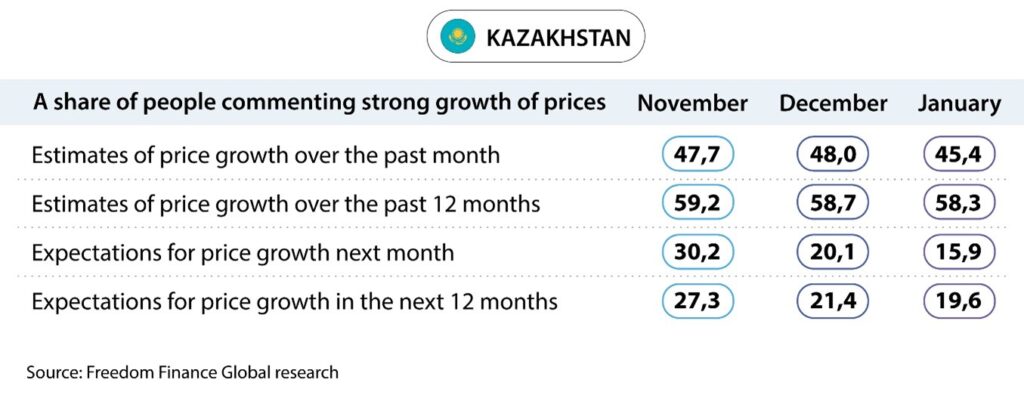
Devaluation expectations reached a seven-month low
Devaluation expectations of Kazakhstanis continued to decline in January and turned out to be the lowest since June 2023. In January, the tenge strengthened by 1.5%, making it the fourth month in a row. Thus, these dynamics most likely became a factor in reducing the devaluation expectations of the population. 47.6% of Kazakhstanis expect the tenge to weaken against the dollar (51.8% in December) in a year, and 27.1% (30.8% in December) in a month.
The Credit Confidence Index slipped by 1.6 points and continues to be in a stable range. Let us note that this index averaged 36 points over the last seven months, which is noticeably higher than it was in the first half of 2023 (31.1 points). These indicators repeat the dynamics of the survey of expectations of economic prospects. The share of Kazakhstanis who believe that now is a good time to get loans fell from 14.1 to 13.2%. At the same time, the level of deposit trust increased slightly: from 34.4 to 35.8%. This is how many Kazakhstanis welcome bank deposits in the current situation, which is the highest value since July 2023.
The level of calm decreased slightly in January. 55.5% of residents of Kazakhstan note that now is a calm time rather than an alarming one (57.9% in November). However, the same indicator is at 1.3 percentage points, higher than in September 2023. Expectations for unemployment growth within one year fell slightly. In December, 16.4% of residents expected it to increase; in January 2924, this figure slipped by percentage points.
Uzbekistan
The Consumer Confidence Index of Uzbek citizens increased again in the first month of 2024 and updated a record value, which now stands at 136.9 points. The index grew by 1.6 points and was made possible mainly due to improved forecasts and assessment of the economic situation in the country. However, on the other hand, there is a noticeable drop in the favorable conditions for large purchases.
Economic estimates reach new records
The sub-index of assessments of changes in the economy over the past 12 months showed the greatest growth among all components, increasing from 129.6 to 135.1 points, which became a new record for the entire period of the study. 60.1% of residents believe that the economic situation in Uzbekistan has improved. In December, this figure was 55.1%. Once again, young people under 29 continue to be more pessimistic about the economy. 56.5% of young people chose positive answers, but among the older generation over 60 years, the same was 64%.
Regionally, the leaders are the Khorezm and Surkhandarya regions, where the regional index was 147.3–147.4 points. In these areas, 68–71% of residents gave a positive answer to the question of improving the economy. These areas also showed the greatest progress in results. In December, the share of positive responses there was approximately 55–56%. The last place was again taken by the city of Tashkent, where 44.6% of residents gave a positive answer, which, however, is slightly better than in December (43.3%).
Expectations for changes in the economic situation over a 12-month horizon have also increased noticeably. The sub-index increased by 3.5 points, amounting to 162.4 points, which is also a new record. The share of respondents who answered positively increased from 69 to 71.6%. The middle age groups 30–44 and 45–59 years showed the greatest improvement in positivity. The share of positive responses in these age groups increased by 5.7 and 5.3 percentage points in January. As a result, the leader was the age group 45–59 years old, where 76.1% chose positive answers. Young people under 29 years of age, as in assessing the economic situation, ended up in last place. Nevertheless, the share of positive answers is still significant and amounts to 68.8%.
In regional terms, the absolute leader was the Syrdarya region, where as many as 81.3% expect the economy to improve in the next 12 months. This area also showed the greatest progress: in December, the same figure was only 65.9%. The capital continues to be at the bottom of the ranking. However, the share of optimists from Tashkent increased from 58.6 to 60.8% in January.
Favorable conditions for large purchases are in doubt
The sub-index of favorable conditions for large purchases showed a noticeable decrease of 2.6 points. As a result, the sub-index reached 84.1 points, which is a new minimum for the seven months of the study. Positive answers regarding how favorable the time is now for large purchases were given by only 40.4% of Uzbek citizens (40.8% in December). However, the most noticeable increase was in the share of those who gave a clearly negative answer: from 47.7 to 51.1%. Confidence decreased the most among young people under 29 years, where the share of positive answers fell from 45.3 to 42.2%, which nevertheless became the best result among all ages. The worst results were shown by the age group of 45–59 years, where the same figure was only 38.2%.
Regionally, the strongest decline in positive responses is observed in the following three regions: Syrdarya region (–5.5 p.p.), Tashkent (–5.1 p.p.) and Jizzakh region (–4 p.p.). As a result, the capital is again at the bottom of the ranking, where the share of selected positive answer options reaches only 33.5%. The best result was recorded in the Khorezm region, where 49% of respondents believe that there are now favorable conditions for large purchases and expenses.
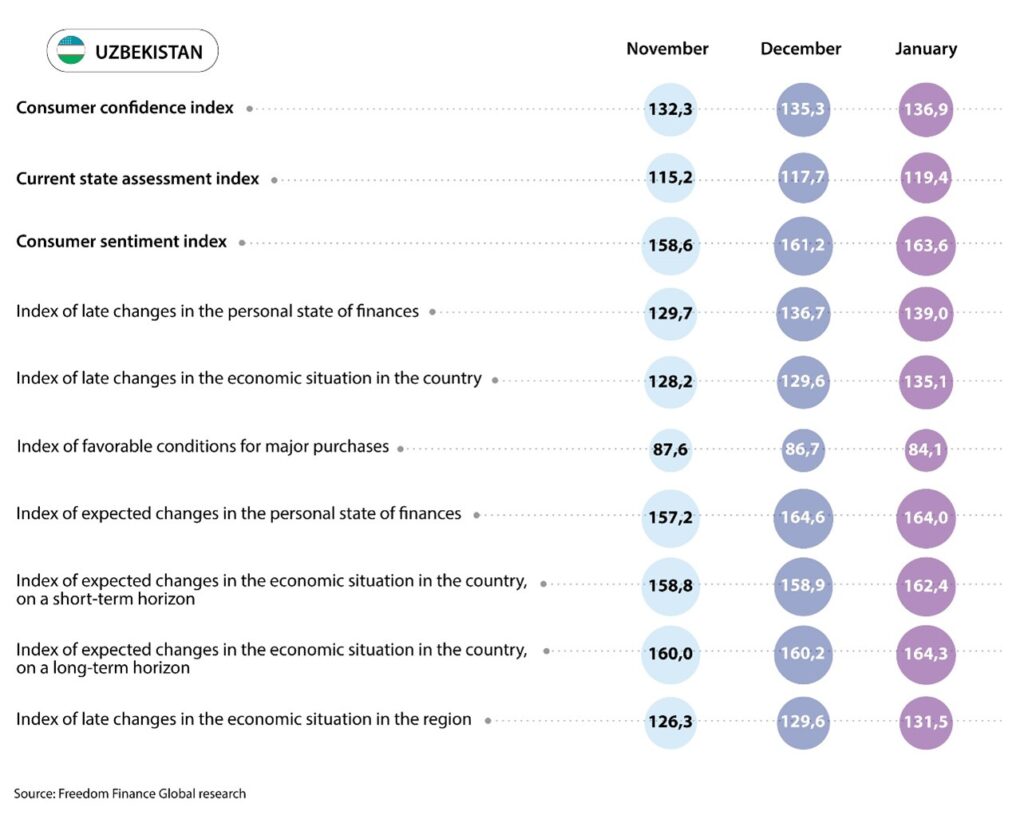
Short-term inflation expectations and estimates fell sharply
Inflation estimates and expectations of residents of Uzbekistan have noticeably decreased over the one-month horizon, but not one year. Thus, the share of those who noticed a strong increase in prices over the past month fell from 29.3 to 23.2%, which is a new minimum. The situation is similar to inflation expectations over a one-month horizon. The share of those expecting a strong price increase decreased from 14.9 to 12.3%, which also became the absolute minimum for the entire period of the study. On the other hand, over the one-year horizon, inflation expectations, on the contrary, increased. If in December, 24.2% of residents expected faster growth during the year, and then in January this share increased to 27.4%. Perceptions of inflation over the previous 12 months have decreased slightly. 46.7% of residents note a faster rise in prices than before (47.2% in December).
According to official data, inflation in January amounted to 0.64% in monthly terms, which is almost two times less than in December and by 18 b.p. less than in January 2023. As a result, annual inflation fell to 8.58%, which is the new lowest value in more than seven years. Among particular food products, «meat, poultry» and «flour» were in the top 2 for the fifth month in a row. Yet flour worries Uzbekistanis less and less. Now this product was noted by 30.9% of respondents versus 59.4% in September. Gasoline and other types of fuel and lubricants continue to be in the top 3, a strong increase in prices for which was noticed by 28.1% of residents of Uzbekistan. According to official data, gasoline prices increased by 3.4% on average in January. The price of propane also increased by 4.8%. As a result, in total for December-January, gasoline prices increased by 6.8% and 10.1% for propane, which did not go unnoticed by the Uzbekistanis. On the other hand, prices for flour and meat decreased in January by 0.2% and 0.5% MoM, respectively, according to official data.
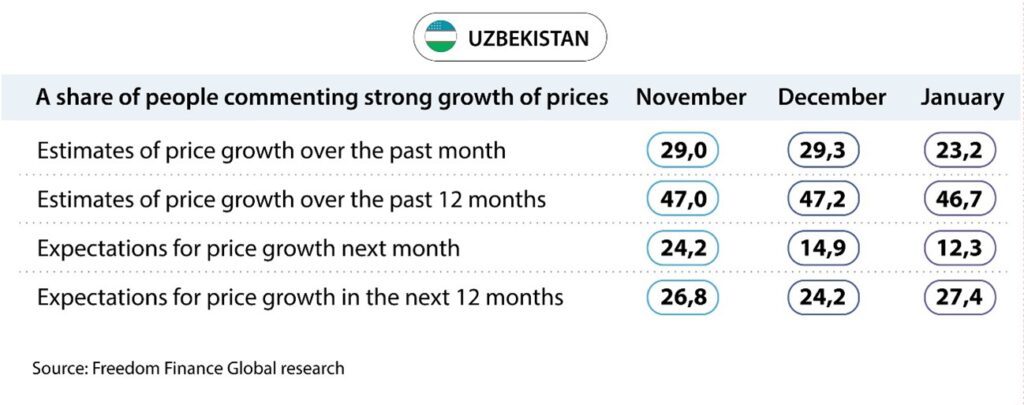
Loans and deposits inspire more confidence
In January, devaluation expectations of residents of Uzbekistan increased slightly. The share of those who expect the sum to weaken against the dollar over the next 12 months increased from 66.5% in December to 68.8%. However, over a one-month horizon, the share of pessimists again decreased slightly from 47.4 to 46.7%. In general, the dollar continues to grow slowly against the sum; in January, the exchange rate increased by another 0.81% and reached new highs.
Credit confidence rose sharply in January and reached new record levels. The number of those who say now is a good time for borrowing increased from 29% in December to 35% in January. The deposit index also recorded a strong positive growth. The index rose from 57.6 to a record 60.5 points. 44.9% of Uzbek citizens (39.8% in December) believe that now is a good time for deposits. The calm level showed a significant recovery in January. If in December, 77.1% of residents said that now is, one way or another, a quiet time, then in January, the share of such answers increased to 81.5%, which is also a new record. At the same time, the share of those expecting unemployment to rise during the year increased from 38.3% in December to 41.7% in January.
Kyrgyzstan
In Kyrgyzstan, the Consumer Confidence Index increased by 2.9 points in January and reached a record 133 points for the entire period of the study. After a slight decline in December, the index continued to grow, which was largely due to improved assessments of the current situation. The greatest growth was shown by the sub-index regarding changes in personal financial situation and the favorability of large purchases and expenses, which increased by 6.2 and 5.2 points, respectively. Estimates for changes in the economy over the past 12 months have also increased noticeably.
Personal financial situation has improved for half of the population
Regarding assessments of changes in personal financial situation, the share of positive answers has sharply increased: from 46.8 to 50.7%. The main driver of growth was youth under 29 years, among whom the share of positive responses increased sharply from 50% in December to 64%. This is the first place among the four age groups. An improvement can also be seen in the middle age groups, but the older generation over 60 years, turned out to be slightly less positive. In January 2024, 46.1% of respondents reported an improvement in their financial situation, compared to 46.4% in December 2023. Residents of rural areas have become a key driver of assessment improvements: 55% of villagers say their financial situation has improved, a 7% increase over 48% in December. Regionally, the greatest improvement in results can be seen in the Talas region, where the share of positive responses sharply increased from 36 to 67%, which was the highest among all regions. In addition, a good increase in this indicator can be seen in Batken (+7 p.p.) and Chu (+6 p.p.) regions. However, the Chu region could not escape the status of an outsider, just catching up with the capital, and shared this title with it with a share of positive responses of 40% in both regions.
Index of conditions for large purchases showed a record
The sub-index of favorable current conditions for large purchases and expenses increased by 5.2 points. 36.7% of Kyrgyzstanis gave a positive answer, which, however, is slightly less than the December figure of 36.8%. As a result, the growth of the sub-index occurred due to a noticeable decrease in the share of negative responses from 45.3 to 41.2%. In terms of age, a significant improvement is observed among young people and the group of 45–59 years. If among young people, the number of those who gave positive answers increased from 39 to 42%, then in the group of 45–59 years old, the share of negative answers sharply decreased – from 46 to 38%. Thus, young people under 29 years took the lead, and people aged 30–44 years, where only 33% positively assessed their ability to make large purchases, gave the worst answers. Regionally, everywhere except Bishkek, an increase in the share of positive answers is recorded. The greatest progress was shown by the city of Osh, where 38% of residents say it is favorable for large purchases and expenses. Also, a strong increase in this indicator can be seen in Talas (+11 p.p.) and Naryn (+7 p.p.) regions. As a result, in January, the leader was the Batken region with a result of 44%, while only 26% of residents indicated that current conditions are favorable for large purchases in Bishkek.
Slight improvement in economic estimates
The assessments of residents of Kyrgyzstan on changes in the economy also recovered. 58.3% of residents believe that the economy has shown improvement over the past 12 months. In December, there were 57.4% of such respondents. The growth driver was people aged 45–59 years once again, among whom the share of positive responses increased from 58 to 60%. Nevertheless, the oldest group of people is still in the lead, among whom 68% note an improvement in the economy. However, among young people under 29, the share of positive responses fell from 58 to 56.5%. As a result, this age group showed the worst final result. For real, the December outsiders the 30–44 age group were only slightly able to get ahead of the younger generation. Among the regions, the city of Osh again showed the best progress, where the share of those who positively assessed changes in the economy increased from 45 to 53%. Actually, this is much less than in November and can be called some normalization of the results. The best figure turned out to be significantly higher and was recorded in the Batken region (77%), which retained first place. The Chu region and Bishkek performed the worst, where the same figure was 42% and 43%, respectively.

Inflation estimates and expectations of Kyrgyzstanis are the lowest in Central Asia
Inflation estimates and expectations of Kyrgyzstanis continued to decline after a short pause in December. Inflation expectations fell especially noticeably reaching a new low for the entire period of the study. The share of those who expect a very strong rise in prices fell from 8.2 to 6% during the month, and over the one-year horizon, the share of pessimists fell from 12.6 to 10.6%. These figures are the lowest in Central Asia.
Estimates of price growth also declined in January, with a particularly noticeable decline in estimates of price growth over the previous 12 months. If in December, 58.9% of Kyrgyzstanis indicated an acceleration in price growth, then in January, the figure was 55.3%, which is also a new record. Over the past month, the decrease in the number of people who noticed a strong increase in prices turned out to be not so significant. The share of such people fell from 33.4 to 32.6%. Official inflation in the country continued to decline in January for the fourth month in a row. The slowdown in inflation again turned out to be sharp: from 6.9 to 5.9% in annual terms, although in October, it was 9.2%.
Among particular goods, we note that Kyrgyzstanis continue to be concerned about the prices of flour, which holds the garland of victory for at least the fifth month in a row. Actually, the share of people noting an increase in flour prices continued to decline. In December, this figure was 62.2%, and in January, it was already 56.5%. The following food products are also in the top 5 for the fifth month in a row: vegetable oil (48.1%), vegetables and fruits (36.1%), sugar and salt (35.5%), and «meat, poultry» (35.4%). Although, on the other hand, official inflation only lists fruit as a product that has shown a significant rise in price over the past year (+20.6%). At the same time, over the year, prices for meat officially increased by only 0.9%, while prices for oils and fats decreased by 10.1%.
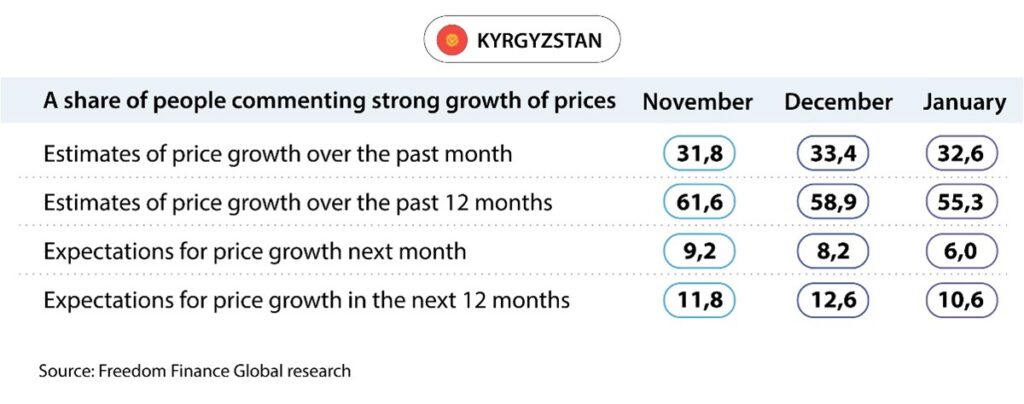
Slight increase in devaluation expectations in Kyrgyzstan
The Kyrgyz som showed a slight weakening in January: by 0.26%, while residents’ devaluation expectations fell back after a slight increase in December and a noticeable increase in September. If in December, 31.7% of residents expected the som to weaken in a year, then in January, this figure was already 28.9%. Regarding the growth of the dollar over a one-month horizon, the decrease in the share of pessimists was approximately the same: from 18.4 to 15.7%. This figure is the lowest during the study.
The population’s credit confidence remains stable. Over the month, the share of those who believe that the current situation is favorable for obtaining loans decreased from 22 to 20.5%. However, the share of negative responses also decreased by 1 percentage point. Deposit confidence of Kyrgyzstanis decreased much more significantly: the share of positive responses fell from 31.3% in December to 26.5% in January. The level of calm among the population continues to grow for the sixth month in a row: 62.8% of residents believe that now is a calm time, while only 23.7% are worried. Last month, these figures were 64.3% and 25.2%, respectively. Residents’ expectations for an increase in unemployment fell for the fourth month in a row and reached a new record. Only 27.3% of residents expect unemployment to rise, although in December, this figure was 29.8%, and in September 36.1%.
Tajikistan
The Consumer Confidence Index in Tajikistan rose from 148.6 to 149.6 points in January after a slight decline in December. Although consumer confidence in Tajikistan continues to be the highest in Central Asia, individual components behaved in different directions. As a result, the country lost its leadership in the sub-index of the favorable current conditions for large purchases. However, two of the five sub-indexes showed significant growth, surpassing previous records. They turned out to be expectations for personal financial situation and expectations for the economy in the one-year horizon.
Expectations for personal financial situation have reached a record
The subindex of expectations for changes in personal financial situation increased by 6.2 points reaching 163.2 points, which is an absolute record in the region. The share of those who expect an improvement in their financial situation increased from 68.2 to 76.2%. In terms of age, the growth driver was the group of 30–44 years, among whom the share of positive responses increased from 62 to 72.6%. Nevertheless, young people under 29 years reserved leadership, among whom 82.7% expect an improvement in their personal financial situation over the next 12 months. For other age groups, the situation is generally similar with residents 30–44 years old. Among the regions, districts of republican subordination took the lead, 82.7% of which residents chose positive answers (71.8% in December). The share of positive responses also increased significantly in the Khatlon region (+8 p.p.) and in Dushanbe (+14 p.p.). Nevertheless, the capital continues to be an outsider with a share of positive responses of 64.3%, which is significantly lower than the overall figure for the country.
Continued growth in expectations for economic improvement
The sub-index of expectations for an improvement in the economic situation in Tajikistan over the next 12 months increased by 2.2 points. Thus, this component of consumer confidence has been growing for the sixth month in a row and reached a new record of 180.9 points. 85.1% of respondents expect economic conditions to improve. In December, this figure was 81.9%. The greatest growth was shown by the older generation over 60 years, among whom 91.4% were optimistic. In December, it was 80%, and thus this age group became the leader in January. The remaining three age cohorts scored from 82 to 86% positive responses. Regionally, the greatest progress can again be seen in Dushanbe, where the share of those expecting an economic improvement increased from 74 to 86.3%. Nevertheless, the best result was also recorded in areas of republican subordination, where it amounted to 89.1%. The lowest figure was reported in the Gorno-Badakhshan Autonomous Region – 74.1%.
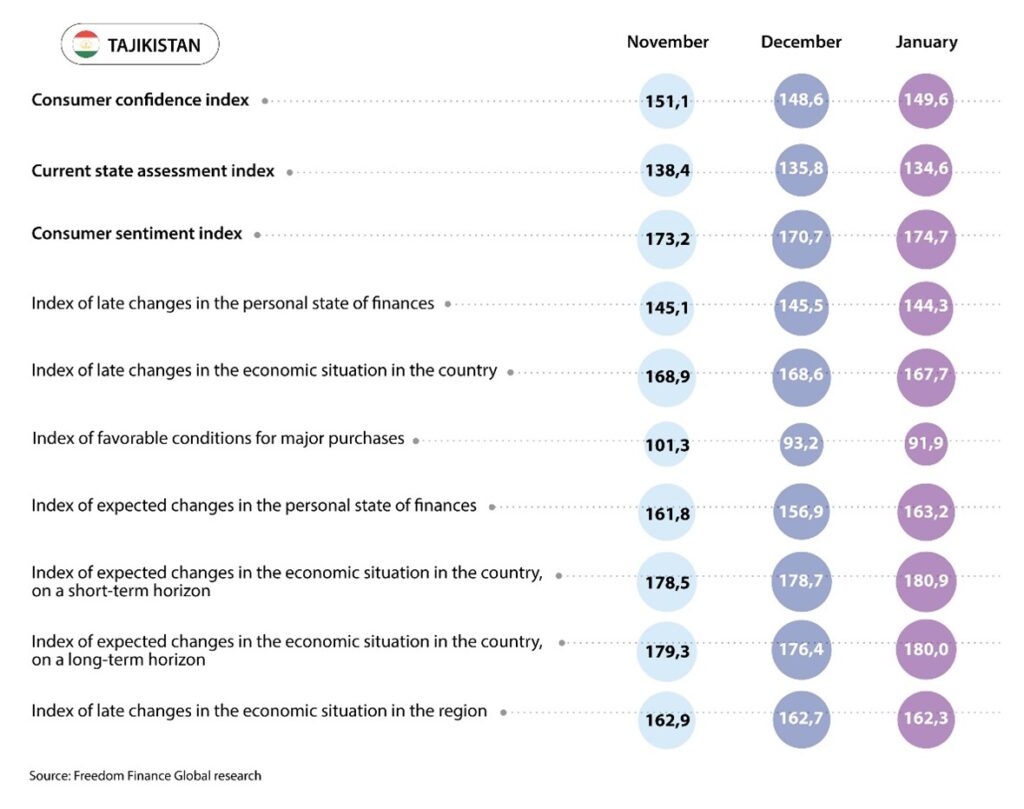
Inflation concerns continued to ease
Inflation estimates and expectations of Tajik citizens, as well as in other Central Asian countries, decreased in January. The most noticeable drop among residents is inflation perceptions, which have been declining for the fourth month in a row. 18.1% noted a strong increase in prices over the past month, while in December there were 25.1%. In addition, the share of those who experienced a faster rise in prices over the past 12 months decreased: from 34.5 to 25.1%.
Respondents’ inflation expectations also decreased. Only 9.3% of residents expect a very strong rise in prices in the coming month, while in December there were 12%. Over the one-year horizon, the share of people expecting faster price growth fell from 12.1% to 10.8%. All of the above-mentioned indicators regarding inflation perceptions and expectations turned out to be record lows for Tajikistan over the entire seven months of the Freedom Finance Global study.
Inflation data for January has not yet been released, but annual inflation accelerated slightly from 3.7% in November to 3.8% in December. This is quite consistent with the December results of this study, when inflation perceptions and expectations decreased slightly, especially in comparison with October or November, and in some places even increased. Among particular goods, the price of flour continues to worry Tajikistan residents the most. 45.2% of residents noticed a strong increase in flour prices, and this figure continues to decline throughout the region. In addition, important food products, such as vegetable oil, «meat, poultry» and «vegetables and fruits» were again among the leaders. The share of those who note a strong increase in prices for these products is 31%, 22% and 21%, respectively. Note that, according to official statistics, flour prices fell by 3.6% MoM, for vegetable oil by 2.7% MoM, and prices for fruit, on the contrary, increased by 4.4% MoM, and for vegetables by 3.7% MoM in December.
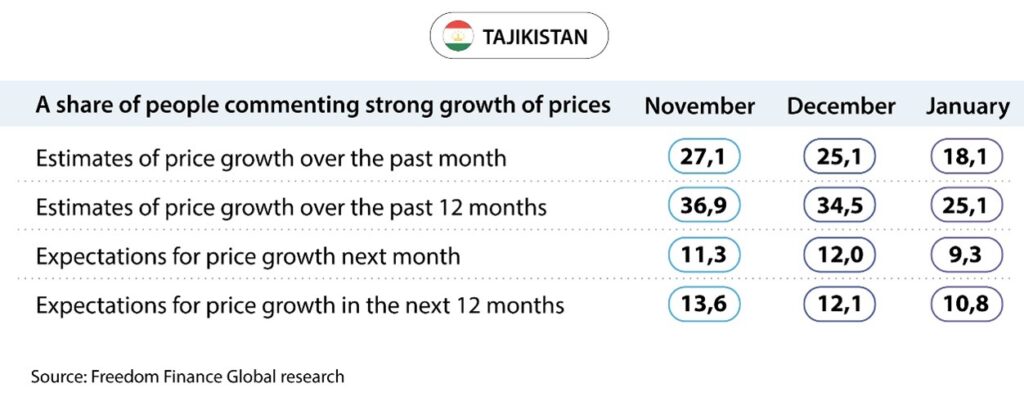
Significant increase in credit and deposit confidence
In January, devaluation expectations increased over a one-year horizon in Tajikistan but continued to decline when residents were surveyed about their prospects for one month. In January, the dollar to somoni exchange rate remained at the same levels for the eleventh month in a row. The share of those who expect the national currency to weaken fell from 17.2 to 14.6% during the month, and 24.5% of the country’s population expects the currency to weaken in a year (22.7% in December).
Credit and deposit confidence indexes increased significantly in January. 28.4% of the country’s residents believe that now is a good time to obtain loans, although in December this figure was 24.6%. Regarding deposits, a similar question caused much more optimism and updated the record. The share of positive responses increased from 52 to 59.8%. The level of calm has decreased slightly: 83.1% of residents say that now is a calm time, while in December this was 87%. Unemployment expectations fell for the fourth month in a row. 22.6% of respondents expect an increase in unemployment compared to 28% in December.
Conclusions
In the first month of 2024, consumer confidence in Central Asia generally recovered after a slight decline in December. However, Kazakhstan stands out in this regard, where the consumer confidence index has decreased slightly. Still, the index continues to be above the neutral limit of 100 points, and residents are more optimistic compared to January 2023. On the other hand, in neighboring Kyrgyzstan and Uzbekistan, the consumer confidence index reached new records, and in Tajikistan, it continues to remain at the highest level among all four countries under consideration.
In January, the greatest improvement in consumer confidence was recorded in Kyrgyzstan, where residents assessed their current situation much more positively. The population of this country turned out to be the most positive in assessing the current conditions for large purchases as favorable, taking over the leadership from the Tajiks. Also in Kyrgyzstan, there is a significant increase in positivity among the rural population, and more than half of the residents note an improvement in their personal financial situation. In Uzbekistan, consumer confidence also reached a record, but due to a noticeable improvement in the positive outlook on the economy. 60% of residents indicate the economy is improving, and almost 72% expect this trend to continue in the next 12 months. In Tajikistan, multidirectional movements of the index components can be noted. Only two of the five sub-indexes showed growth, but this was enough to generate growth in the overall index. Expectations for improvements in personal financial situation and the economy have reached new records, and overall the highest levels in the entire region. In Kazakhstan, the decline mostly occurred in matters of personal financial situation. Let us also note an interesting trend: for the seventh month in a row, residents have shown relatively high expectations for economic improvement.
Inflation estimates and expectations have dropped significantly across Central Asia clearing important barriers. Inflation expectations fell especially noticeably in Kyrgyzstan, where they reached new lows for the entire period of the study and are minimal throughout Central Asia. This is also supported by a sharp slowdown in annual inflation over the past three months. Inflation perceptions fell the most in Tajikistan, also reaching new lows. If in September, flour prices worried more people, now inflationary perceptions have returned to pre-September levels. Expectations for a strong rise in prices in this country also fell and turned out to be slightly higher than in Kyrgyzstan. In Kazakhstan, there is also a breakdown in inflation expectations, which are also supported by a similar survey of the National Bank. Both in the one-month and one-year horizons, inflation expectations reached minimums for all 13 months of observation of this indicator. But in Uzbekistan, the situation with inflation turned out to be a little less clear. Inflationary perceptions and expectations fell in the one-month horizon, but in the one-year horizon, more Uzbek citizens expect an acceleration in price growth.
In general, devaluation expectations have changed slightly in Central Asia. Kyrgyzstan especially stands out, where these expectations have dropped to record lows. The largest decline was recorded in Kazakhstan, where the tenge strengthened for the fourth month in a row, just as devaluation expectations were falling. Nevertheless, expectations are still higher than those recorded in May 2023. In Uzbekistan and Tajikistan, on the contrary, there is a slight increase in devaluation expectations over the one-year horizon, but in general, they remain at stable levels recorded in previous months.
The seventh wave of research into consumer confidence among the population of four Central Asian countries shows continued growth in positivity. Despite a slight across-the-board decline in December, the two countries are setting new records for consumer confidence, while Tajikistan continues to remain at levels unattainable by other countries. An almost universal decline in inflationary perceptions and expectations was the main trend in January. New lows have been reached in some countries. Thus, we can conclude that concerns about rising prices in Central Asia have taken a structural step back. All this is also confirmed by the continuing decline in inflation in the region. Still, it is too early to talk about victory over inflation, since in some countries we can see that people are worrying about prices for some categories of products. Besides, in almost all countries, rising food prices worry people first of all, and all interested parties represented by the business and the government should focus on stabilizing them.






